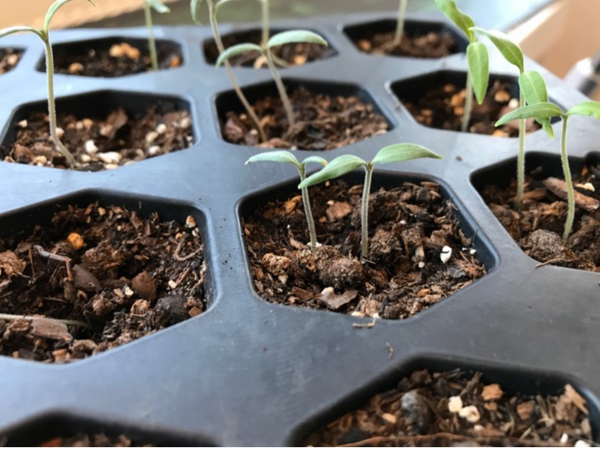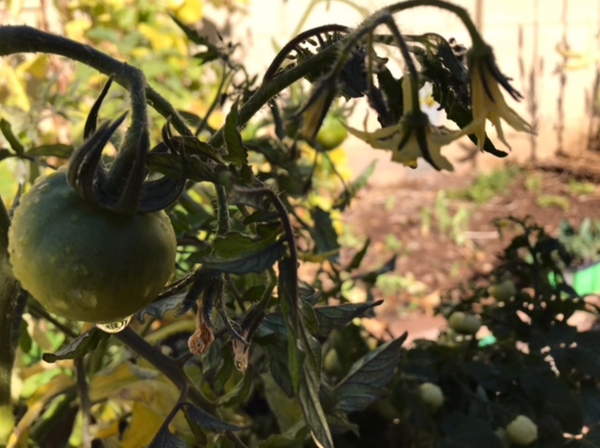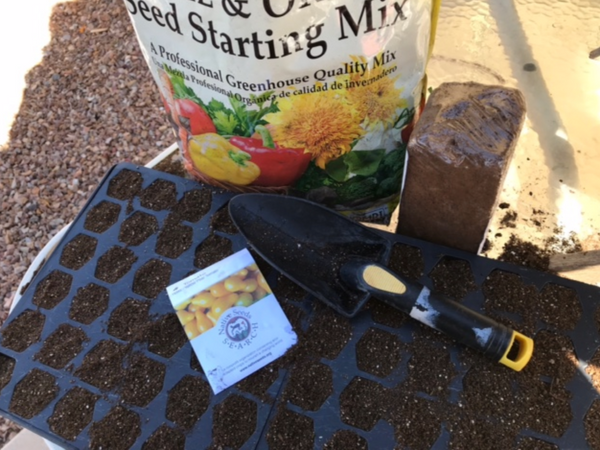
By Melissa Kruse-Peeples, NS/S Education Coordinator and Laura Neff, NS/S Education Assistant.
Tomatoes are one of the most popular garden foods grown by home gardeners. The diversity of tomato varieties and uses have increased dramatically from its original domestication in the tropical climates of Central and South America to the point where now it is use in cuisines from all around the world. While popular, tomatoes can difficult to start from seed because of it's slow maturation rate and sensitivity to heat and frost when young. Tomato should be started from seed indoors at least 8 weeks before the threat of frost has passed. Then once the threat of freezing temperatures has passed and soil warms up the tomato plants can be put outside. For the low desert regions, including Tucson and Phoenix this means that tomato seed starting time correlates to the holiday season of late November through the first week of January. Getting a jump on starting tomato seeds now also ensures that plants will produce fruit before the heat and dry weather of early summer sets in.
SELECTING VARIETIES
Designations to look for when selecting a variety for the low desert would include heat tolerant, arid-adapted, or dryland variety. These are important characteristics in the low desert because fruit set typically does not happen when conditions are greater than 85 degrees F and especially when night time temps do not dip below 75 degrees F. But there are varieties known to set fruit at 90 degrees F or higher. Varieties with a history of growing in warmer climates have traits that make them well adapted to desert consideration. For example, Punta Banda tomato in the NS/S collection is known to produce fruit even in the heat and dryness during the month of June in the Tucson area and Texas Wild Cherry is a consistent producer in warmer temperatures.
Many packets have a "Days to Maturity" designation. Days to maturity typically refers to days after plant is transplanted, not after the seed is started.Typically the earlier they mature, the better chance you have to receive fruit before the high temperatures hit. In the low desert, the high temperatures seem to hit us earlier and earlier but tomato production really slows down in late May - July. Starting early and selecting early maturing varieties help ensure a harvest in the Spring.
PLANT AND FRUIT SIZE
The size of both the tomato plant and fruit is a factor to consider when looking at different varieties. Are you planting in ground or in a container? Smaller plants tend to do better in containers but typically need a 5 gallon size container or larger per plant to thrive. Flamenco tomato is a good choice for container gardeners as the plants will produce saladette sized fruits on plants that are just 1 1/2 feet to 3 feet tall.
When it comes to the fruit, smaller tomatoes tend to keep better on the plant and smaller varieties tend to have less of a chance of splitting with inconsistent watering. Small fruit varieties like cherry and grape types are also have better fruit set in Southwestern conditions than larger fruited types. Save the larger fruit types for the late Monsoon and Fall seasons when they will produce when day and nighttime temperatures are more ideal.
INDETERMINATE VS. DETERMINATE
Tomato varieties are also classified into categories based on their growing habits. Indeterminate varieties are those that grow and produce flowers continually and are recommended for desert growing. They may slow down in the height of the summer but will thrive again in the late summer through Fall. It is also possible to overwinter and keep indeterminate varieties producing for a few years. On the other hand, determinate varieties stop growing once flowers at the terminal bud sets fruit. Therefore they tend to have fruit ripen within a similar 2 week window and grow smaller plants. Determinate varieties are recommended for containers and for Fall in the low desert when they can produce an abundance quickly before colder temperatures set in.
Lastly and most importantly, when selecting a tomato, determine how you want to use tomatoes in the kitchen! Do you want them to snack on right off the plant? Cherry tomatoes are perfect. Looking to make a sauce? Paste tomatoes would be your go to. Want them sliced in a salad or sandwich? A larger, sweeter variety would be your ideal tomato variety.

Tomato seedlings in seed starting tray.
STARTING SEEDS
TIMING AND NEEDS
Be sure to sow the seeds indoors 6-8 weeks before the last frost in the area. For the low desert that means starting early December to mid January for putting in ground by March 1st. Based on temperatures in the Phoenix area over the last several years, Valentine's day of Feb 14th is appropriate. Starting by March means the plants would be setting fruit in April through Early May. Late May to July is often too hot and dry for most varieties to set fruit. Not to fear, in the low desert we have a second tomato season. Set out new plants during the mid-late Monsoon season for fruit production through the Fall and if plants set outside in the Spring were indeterminate varieties they will come back to life and begin setting new fruit in the late summer.
Tomato seeds need heat for germination. The ideal temperature is 75 degrees. A heat mat help speed up germination and can be removed once seeds have sprouted. A humidity dome can also be used for the same purpose to warm up germination environment and also ensures consistent moisture. Remove humidity dome once seeds have sprouted.
Seeds also need lots of light. A south facing window is rarely enough light. A 2 bulb florescent light or something similar is necessary. Lack of sufficient light leads to tall, leggy starts that can be weak and unable to support emerging leaves.
SOIL PREPARATION AND CARE
The key to any good seed starting medium is that it is fine, uniform, well aerated, and will hold moisture. You can purchase a premixed seed starting soil mix or make your own. A good recipe is to use one third each of fine grained compost, re-hydrated coconut coir, and vermiculite or perlite. Many of these materials are available at the NS/S retail store in Tucson. If you find the soil to be hydrophobic (water pooling on top of the soil), mix in more coco coir or peat moss. Seeds will need soil with nutrients or fertilizer after second set of leaves appear. At that point starts are often large enough to move into a larger container with potting soil.
Almost any container with drainage will do to start your seeds. Recycled yogurt containers, strawberry cartons, or specialty seed starting trays will all do. Something that is a few inches deep is best. Place the seed on top of the starting mix, add a light layer of soil on top, only enough to ensure they are in full contact with the soil on all sides.
Tools needed for seed starting.
Watering is a necessity for anything that you want to grow. When starting seeds, be sure to use spray bottle to keep soil moist. This will ensure that the seeds, developing roots and young sprouts will not be disturbed in any way. DO NOT over water. Leads to dampening off which is a disease or condition, caused by a number of different pathogens that kill or weaken seeds and seedlings before or after they germinate.
TRANSPLANTING
Before transplanting tomato starts into the garden, ensure the temperatures are right and the plant is acclimatized to the outdoor environment. The soil temperature should be at least 60 degrees F and 80 degrees F is better. If it is too cold, you may have stunted growth and possibly nutrient deficiencies. Nothing is gained by starting too early. In the low desert this has typically been between mid Feb - Mid March depending upon your specific micro-climate. The spot within your garden you select for tomatoes should be full sun with 6-8 hours of sun. You can always cover with a shade cloth later in the summer to protect your tomatoes from the heat and suns rays. Be aware that soil temperatures are always highest in containers and raised beds. Begin to acclimatize the started plants to the outside temperatures, wind, sunlight for an increasing amount of time for 5-7 days before burring int he ground.
Bury the tomato plant all the way down into the ground to the first leaves, deeper than the soil line of the transplant. You can trim off bottom leaves leaving only the top 4 inches – at least 2 full pairs of leaves. Tomatoes will grow additional roots along the burred part of the stem winch allows for faster growth and more resilience against dry periods. If your stem is particularly long consider planting sideways in a trench rather than a single hole. Application of fish emulsion or other organic fertilizer helps keep the transplant from going into shock.

Green tomato and flowers.
OVERWINTERING
In their natural, tropical habitat tomatoes are a perennial plant and can also grow perennially in the low desert. But they are frost sensitive and can be damaged when temps 40 degrees so care for them over the winter. Cover with old sheets or frost cloth ensuring that the cloth does not sit directly on the plant. Heavy weight and wet frozen cloth can damage plants. You can also add light bulbs or non LED Christmas lights for a warmer micro-climate under the sheet. Pick all fruit before freeze and ripen on kitchen counter, or use as green tomatoes. Prune away dead parts touched by frost only after cold spell has passed. The extra volume can help protect the plant during the frosts.
Being a tropical plant, tomatoes need the heat and sunlight for fruit to mature and ripen so they will definitely slow down in the short days of the winter but will flourish again when the temperatures rise. Caring for tomatoes over the winter can be a lot of work but is worth it and you will be harvesting ripe tomatoes early in the Spring. Once cold temperatures have passed prune back to promote new growth.

